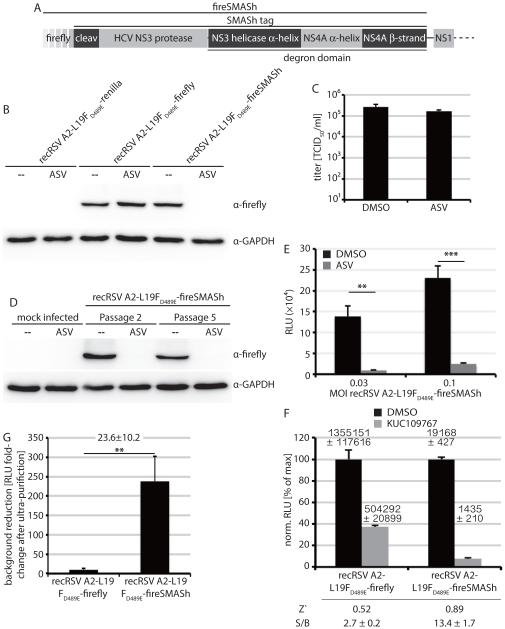Figure 3.
recRSV-L19FD489E-fireSMASh allows induced reporter degradation. A) Schematic of the fireSMASh cassette inserted into the recRSV-L19FD489E genome (cleav: HCV NS3 cleavage site). B) Immunodetection of firefly luciferase after infection of cells with the specified recRSV-L19FD489E strain in the presence or absence of the NS3 inhibitor asunaprevir (ASV) and SDS-PAGE of cell lysates. Cellular GAPDH levels were determined as loading controls. C) Peak recRSV-L19FD489E-fireSMASh progeny titers after incubation in the presence of 3 μM ASV or vehicle (DMSO). (N = 3; means ± SD are shown). D) Immunodetection of firefly luciferase after serial passaging of recRSV-L19FD489E-fireSMASh and reinfection of cells in the presence or absence of 3 μM ASV. Passage 2 (P2) and passage 5 (P5) are shown, GAPDH levels were determined as loading controls. E) Firefly activity after growth of recRSV-L19FD489E-fireSMASh in the presence or absence of 3 μM ASV. Cells were infected at the specified MOIs and harvested 44 hours post-infection (N = 3; means ± SD are shown; 2-tailed t-test, **: p < 0.01; ***: p < 0.001). F) Signal window of the recRSV-L19FD489E-fireSMASh reporter strain was calculated as described in figure 2D N = 3; means ± SD are shown); numbers above the columns show raw data means ± SD. Z’ and S/B values are specified below the graph. G) Fold-change of contaminating firefly luciferase after gradient purification of recRSV-L19FD489E-firefly and recRSV-L19FD489E-fireSMASh preparation to unpurified recRSV-L19FD489E-firefly (N = 3; means ± SD are shown; 2-tailed t-test; **: p < 0.01).

